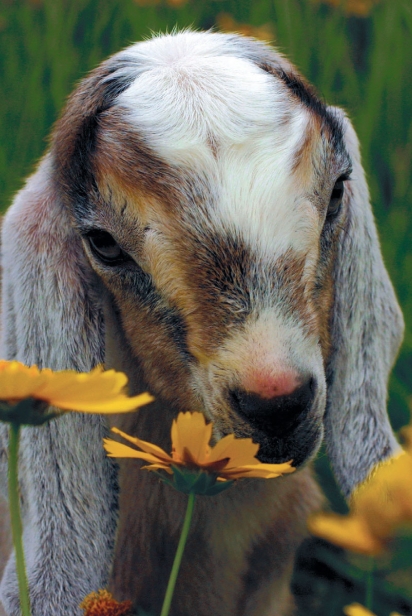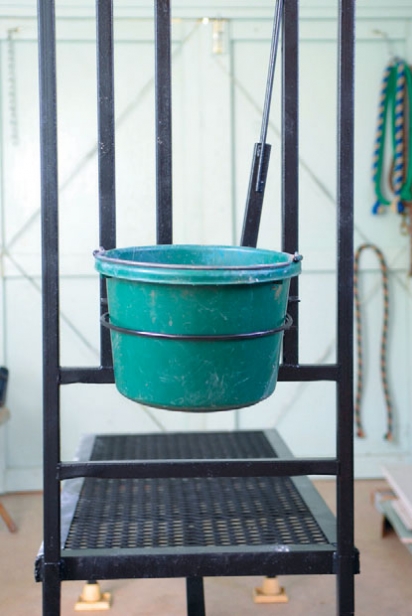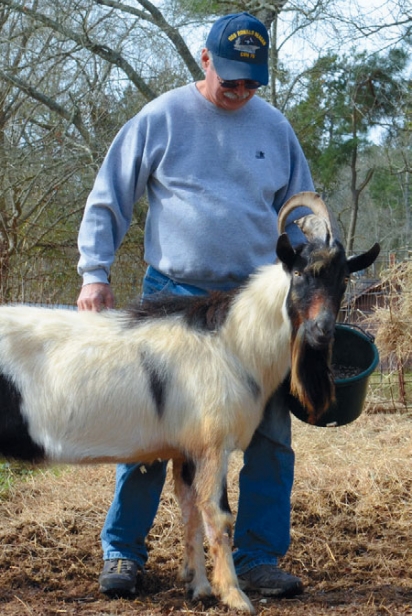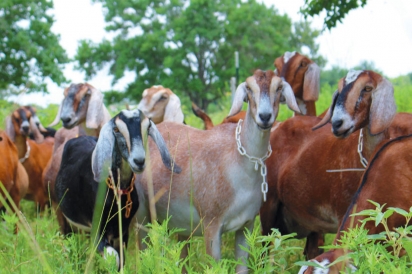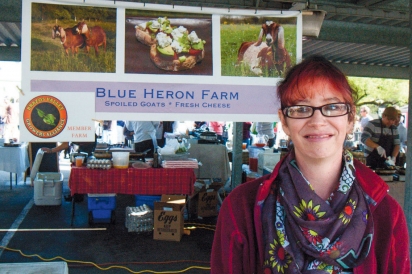Goats Galore in Houston, Texas
No Kidding in the Dairy Kitchen
Carrie Underwood is pregnant. With twins, most likely, but triplets are always a possibility. “She was carrying much higher yesterday,” said Blue Heron Farm co-owner Lisa Seger, observing Ms. Underwood’s udder height as she waddles away with the other goats, excited to enter the new patch of green pasture just opened up by Lisa’s husband Christian. Udder position is an important barometer this time of year, as the pregnant does enter kidding season.
At Blue Heron Farm in Waller County, the Segers have a camera installed in the birthing barn. It transmits images to their bedroom, so they can monitor and still catch some shut-eye. No matter how sleepless the previous night, the next morning the goats need to be milked. The fresh milk needs to be processed. Cheese needs to be made. And if it is market day, Lisa goes off with her tent and ready products, too. Blue Heron Farm is one of a handful of local goat dairy farms producing artisanal goat cheese for Houston-area restaurants, grocery stores and farmers markets.
A true labor of love, success in these micro-dairy businesses requires a missionary devotion to the goats, to the cheese, to one’s customers. Part herder, part vet, part chemist, part marketer, part distributor, it is not uncommon to invest a life’s savings and the better part of each 24-hour day to produce small quantities of these soft cheeses imbued with garlic, basil, apricots, lemon and other savory ingredients.
New Caney goat farmer Julie Hammond and her daughter, Kimberly, started showing dairy goats and making soaps and lotions as a hobby in 1999. After losing her job in 2009, Julie decided to go all in and use her goat milk to make goat cheese. “Soaps and lotions are sold at every craft show and farmers market and it’s hard to make a living off the profits,” Julie said. “Everyone can make soap in their kitchen,” as she puts it. “In cheese, I had a better chance.” UPDATE - HAMMOND FARMS IS NO LONGER OPERATING
Hammond took to her new vocation in student-like fashion—taking courses on goat husbandry and cheesemaking, while consulting often with her state and county inspector. In the commercial cheesemaking business, the rules of production are very specific, and all are closely monitored by each farm’s inspector. There are set guidelines for storage, specific production temperatures to maintain, construction dictates for your dairy kitchen and mandates for disposing of byproducts. One of those byproducts is whey. Whey is the liquid that drains from the fermenting cheese as it separates from the milk solids during the cheesemaking process. Watery as it is, it is also full of proteins and nutrients, and you can’t just drain it away. The same nutrients and proteins make it excellent animal feed, and Lisa and Christian feed it to the pigs they raise each year for meat. For the same reason, an area pig farmer is happy to take the whey from Hammond Farm to feed to his pigs.
At the heart of the operation is the pasteurizing machine, a fancy stainless steel double boiler with multiple thermometers and a mixer. Costing just this side of a small sedan, it sets the commercial cheesemaker apart from the backyard producer. “A huge barrier to entry in this business is the cost of the pasteurizer, and it’s the one thing that makes you legal,” Lisa said. Knowing these costs can keep good cheesemakers out of the business, the Segers recently invited former Blue Heron Farm intern and novice cheesemaker Jamie Glover to use their kitchen. “We rent her the kitchen one day a week as an incubator,” Lisa said. “Hopefully, she’ll outgrow us and become a big awesome cheese maker. That’s our plan for her.”
The Segers also host tours and outdoor dinners at Blue Heron Farm. For guests, it’s a fun outing. For the Segers, it’s an opportunity to preach the benefits of sustainable farming. Their farm includes cats, dogs, hogs and poultry, a robust fruit and vegetable garden, and a frenetic flock of guinea fowl, which maintain their invite solely because they eat ticks. “Every animal here has to have a job,” Lisa said. At the same time, nothing goes to waste in their kitchen. They compost everything in their home kitchen, except the nice big vegetable scraps. These go to the pigs. And then there is the CrockPot, a much-appreciated appliance when it comes to their “whole animal” approach in cooking.
The dairy goat of choice for farmers in south central Texas is the Nubian goat. With droopy ears and soft eyes, they have a petlike quality that is hard to resist, even to veteran goat owners. But, make no mistake: They are the true moneymakers on a goat dairy farm, producing a high-butter fat milk perfect for cheesemaking. And when the does are in full milk production, it’s all hands on deck for cheese production.
At Hammond Farm, Julie Hammond’s mother, Dolores McClere, helps with the cheesemaking. At age 79, she puts in her hours and, laughing, admits a 10-hour day is no exception. Julie’s husband Denny helps with feeding, barn maintenance and just about anything else that needs to get done. “Sometimes I’ll go to the Saturday farmers market and I haven’t been to bed,” said Julie of high cheesemaking season.
FROM PASTURE TO TRIPLE CREAM BRIE, THE STORY OF SHOW GOAT CREAMERY
Considering the amount of TLC that rookie cheesemaker Jamie (Glover) Smith invests into her Texas Triple Cream Brie, it’s no wonder she refers to each wheel as a “cheese baby.” Jamie birthed her first batch of this unique artisanal cheese less than a year ago, but the first production of her Show Goat Creamery has been several years in the making, and started with Glover’s sense of disconnection from the food she was eating and her growing concerns over the treatment of agricultural animals.
“I started looking around for farm internships to learn more about the food system,” said the Houston native and avowed cheese connoisseur, “and I learned about Lisa and Christian [Seger] and I absolutely loved their story and how they abandoned the corporate world to pursue their dreams and I found that passion inspiring.” Jamie connected with the Segers and spent a year interning on Blue Heron Farm. “I have never been happier than out on their farm. I loved working with the goats and learning how to make cheese,” she said. Jamie fine-tuned her understanding of cheesemaking while working for Lindsey Schechter at Houston Dairymaids and it was here that her idea for her brie, a mix of goat and cow milk, took seed. It takes three days to make her brie and another three weeks to ripen it. “It took me a year to develop the recipe,” she said, “and to learn how to manage the mold growth and proper storage and a system for making it work.” Jamie is now a business develop manager.
About this time, the Segers invited their former student out for dinner and the trio came up with the idea of renting out the Blue Heron Farm kitchen to Jamie to start her fledgling business. The response to her triple cream brie has been fantastic and she’s already working on new cheeses, including a beer cheese. She also developed a cream cheese that she decided to name Ms. Keaney’s Cream Cheese. It is named after her favorite middle-school math teacher, and a percentage of the profits of sales of this cream cheese goes to support STEM (Science, Technology, Engineering & Mathematics) education for girls.
THE BUCK BUTTS IN
Every tango takes two and on a dairy goat farm that role goes to the male goat, known in industry parlance as a buck or, at Blue Heron Farm, as the “dude.” With a one-track mind and a sometimes distinct smell, bucks are, of course, key to the success in the dairy goat business.
Lisa and Christian Seger keep two bucks at their farm—one is on loan to replace an original buck that recently died. “One buck would probably do, but if we keep any of the daughters, we don’t want to breed them back to their dads,” Lisa said. Female goats, on average, go into season in August and breeding starts in September. Birthing begins in February and lasts until May.
Like other dairy goat farmers, the Segers give their girls a year off, but Elle Mai and two other does had unplanned pregnancies this year. The Segers suspect the newcomer— who spends his day in a separate pen along with his frat buddy—is the dad. A small break in the fence seems to be the point of encounter and the girls can be “shameless,” Lisa said. “If we are going to sell the babies, we’ll have to have DNA tests to register them,” Lisa said. “We can get all Jerry Springer around here.”
Lisa said the life of a buck can definitely be demanding, which may explain why they typically live eight to 10 years, while does live to about 12. “Rutting is really rough, they fight all the time, they lose weight,” she says. “It’s physically demanding on them.”
Julie and Dennis Hammond keep four bucks on hand, but they have also decided to take a less romantic approach and employ artificial insemination. They own a tank of very cold nitrogen for keeping the semen frozen until needed. And Julie took a class to learn the procedure. “We decided to do AI because we wanted to bring more superior genetics from other proven sires,” Julie said. “Also some of our neighbors complained about the smell.” She’s not partial to odorous nature of her male goats either, and is glad Dennis is willing to tend to their care. “My mom and I keep him out of the kitchen when he’s been working with the bucks,” she said chuckling. “If he needs something, we’ll hand it out the door.”
“When the milk is ready, it’s ready,” said Dolores. This year, Julie has added another variety of goat to her herd: the Alpine. While Nubians are known for their high butterfat, Alpines are known for sheer milk output and Julie plans to blend the two to produce even more cheese. Unlike the production of hard cheeses, which can take a heavy investment of years to age, the cheeses made at Hammond and Blue Heron farms are made in just a few days.
The Segers make chevre—“goat” in French—and feta in a variety of flavors. In 2013, they also started making cajeta, a Mexican goat milk caramel in partnership with milk producers Fairwoods Farm and TLC Farms. The Hammonds make feta in eight varieties, including a ribbon-winning Sun-dried Tomato Basil. Like the Segers, she buys milk to augment her own herd’s production and she sells every ounce she makes.
Cute as the playful baby goats are, kidding season also brings stress and hardship for the farmers. They have to deal with complicated births and stillborns. And then there is the difficult decision each year of choosing which kids will stay at the farm and which will be sold to other farms and backyard producers. Julie also sells some goats each year for their meat. “It’s hard not to get attached, but as a farm and a business you have to look at culling and what’s performing and what can go,” she said.
The Segers, who left their city jobs nine years ago to start the farm, are now facing the sad task of seeing some of their original goats grow old and die. The size of their farm—10.5 acres—allows them the luxury of letting the older goats retire. Still, they say it’s hard each time an animal dies, just as hard as the stillbirths that come each kidding season. “We did just lose our first buck this week, our first dude,” Lisa said. “We’ll have a big spike of the girls pass away and knowing that is kind of weird.”
While this is a business, to be sure, both dairy farmers admit the goats are also family. Each Blue Heron Farm newborn spends his or her first night in a toddler’s playpen in the house—“we make a lot of runs to the store for paper towels,” said Lisa. And all the goats know their names, she maintains. Christian, meanwhile, remains a skeptic. "Some of them may know their names,” he said, giving Lisa a glance indicating a well-worn point of discussion. “We try not to have favorites,” Lisa added, “but some are fully more awesome than others.”
WHERE TO FIND LOCAL GOAT DAIRY PRODUCTS FROM FEATURED PRODUCERS
Blue Heron Farm
Urban Harvest Market (Sat 8am–noon)
Rice University Farmers Market (Tues 3:30–6:30pm)
Revival Market carries cajeta year-round and chevre in season. Houston Dairymaids carries cajeta and bourbon-flavored cajeta.



